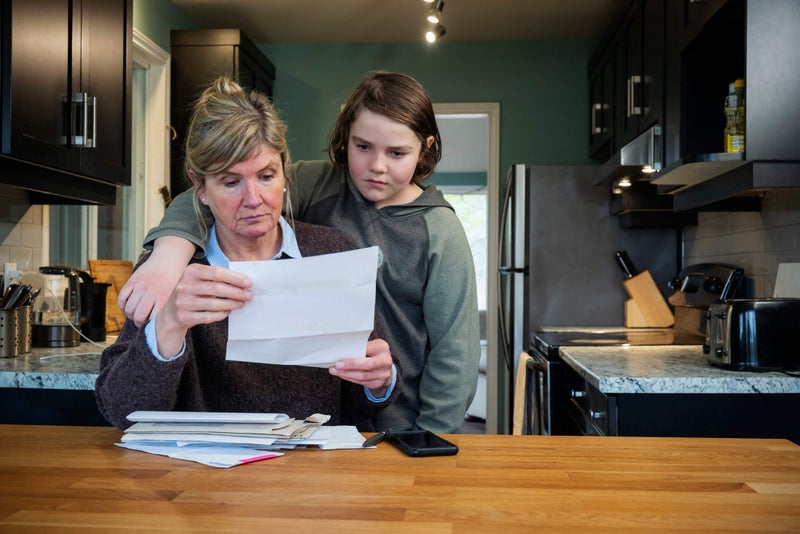Denied and distressed: Half of applicants have been turned down for a loan or financial product since the Fed began raising rates

The Bankrate promise
At Bankrate we strive to help you make smarter financial decisions. While we adhere to strict , this post may contain references to products from our partners. Here's an explanation for . The content on this page is accurate as of the posting date; however, some of the offers mentioned may have expired. Terms apply to the offers listed on this page. Any opinions, analyses, reviews or recommendations expressed in this article are those of the author’s alone, and have not been reviewed, approved or otherwise endorsed by any card issuer.
Interest rates haven’t been this high for more than two decades thanks to the Federal Reserve’s vigorous inflation fight, and Americans are paying the price — not just because their borrowing costs are more expensive.
Half of Americans who’ve applied for a loan or financial product since the Fed started raising its key benchmark rate in March 2022 have been denied, a new Bankrate survey finds. Further, 17 percent have been denied more than one loan.
Americans are getting rejected for the credit lines that many households have found crucial for absorbing the cost of higher prices, from new credit cards (at 14 percent) to personal loans (at 10 percent). Some are even having trouble accessing the loans that could help them pay off those balances more quickly, such as balance transfer cards (6 percent) or debt consolidation loans (6 percent).
More than 8 in 10 Americans who’ve been denied (82 percent) say that the rejection negatively impacted their finances, Bankrate’s poll also found. To access the credit they needed, almost 1 in 4 applicants who were denied (23 percent) pursued alternative financing, such as cash advances or payday loans — coming with even higher interest rates that can be as high as 650 percent.
Americans’ credit troubles come just two years after the Fed first hiked rates to combat post-pandemic inflation — and almost a year after some of the largest bank failures in U.S. history. Banks aren’t as skittish about lending money as they were immediately after Silicon Valley and First Republic Bank collapsed, according to a senior loan officer survey from the Fed. Yet, accessing credit is still tougher today than it was before the pandemic — and by design. The tide may turn only if the U.S. economy continues to avoid a recession and the Fed eventually cuts interest rates.
Banks and other lenders are constantly mindful of the potential downsides of both the changing economic environment, as well as the risks that people get behind on payments — or worse. One way they account for that is for financial service firms to hold on to more of their money.— Mark Hamrick | Bankrate senior economic analyst
Key statistics on Americans’ access to credit since the Federal Reserve began raising interest rates
- The odds of getting approved for a loan are currently a coin flip: Half of Americans who’ve applied for a loan or financial product since the Federal Reserve began raising interest rates in March 2022 have been denied, with credit card applications (a combined 19 percent for both balance transfer and new cards) and credit limit increases (at 11 percent) denied the most. Slightly more than 2 in 5 applicants (or 41 percent) have been approved for all that they applied for.
- Higher rates are making it harder for Americans to access credit: Slightly more than 1 in 5 (21 percent) Americans say that it’s gotten harder to obtain credit since the Fed began hiking borrowing costs, but that share surges to 50 percent for Americans who have credit scores considered “poor” (in the 300-579 range) and 38 percent for those with “fair” credit (580-669) on FICO’s scale.
- Americans feel financial pain when they’re denied credit: More than 8 in 10 denied applicants (82 percent) say the rejection negatively impacted their finances in some way. Specifically, 32 percent say they’ve felt more stressed about their finances and 23 percent have turned to alternative financing to access the credit they needed, such as payday loans or cash advances.
- The possibility of being denied a loan kept more Americans from applying: About 1 in 7 Americans (15 percent) who haven’t applied for loans or financial products since the Fed began raising interest rates say the reason they haven’t sought any financing is because they didn’t think they’d get approved. Another 17 percent say higher borrowing costs were what deterred them.
Half of Americans who’ve applied for a loan or financial product since March 2022 have been denied
One of the ways higher borrowing costs wrestle inflation is by slowing the flow of credit to households and businesses. Lending doesn’t halt, but financial firms grow pickier about who they approve for a loan, assessing factors such as income, outstanding debt and payment history.
“It is all about the potential ability to pay back money owed and the risk that some will not be paid,” Hamrick says. “As the Federal Reserve brought out high-powered ammo — in other words, higher interest rates in response to historically high inflation — tighter lending is a natural byproduct.”
Overall, a slightly smaller share of applicants (41 percent) say they were approved for their loan or financial product applications. A smaller 5 percent say they either don’t know or can’t recall, while 4 percent prefer not to say.
When it comes to the financial products that applicants are getting denied, those span:
- A new credit card, excluding balance transfers (14 percent);
- Credit limit increase on a credit card (11 percent);
- Personal loan (10 percent);
- Car loan or car lease (9 percent);
- Insurance, such as for homes, cars or rentals (8 percent);
- Debt consolidation loan (6 percent);
- Balance transfer credit card (6 percent);
- Mortgage (5 percent);
- Home/apartment rental application (5 percent); and
- Home equity loans/home equity lines of credit (3 percent).
But some Americans are having an even harder time accessing credit. Generation Z (ages 18-27) and millennials (28-43) are seeing the highest rejection rates, at:
- 58 percent of Gen Z applicants denied at least one loan; along with
- 60 percent of millennials;
- 49 percent of Gen X (ages 44-59); and
- 33 percent of baby boomers (ages 60-78).
Parents with children under 18 are also encountering more barriers. More than 6 in 10 (or 62 percent) of parents with children younger than 18 who’ve applied for a loan or financial product since the Fed’s first rate hike in March 2022 have faced a denial, versus 39 percent of those with children 18 or older and 49 percent of those who aren’t parents or guardians.
Whether it’s the price of child care or groceries, parents have been dealt some of the toughest blows from the post-pandemic inflation surge. Meanwhile, younger generations have been especially vulnerable to higher prices as they start their lives in a costly era that also features high rates and crushing student loan debt.
Higher-income Americans have been more likely to turn to financing since the Fed started raising interest rates, Bankrate’s data shows. Yet, lower-income applicants were most likely to face a denial, at:
- Under $40,000 a year (56 percent);
- $40,000 to $79,999 a year (49 percent); and
- $80,000 or more annually (48 percent).
“Tighter lending requirements demand higher credit scores, potentially larger down payments or more documentation,” Hamrick says. “Those with lower incomes or less robust credit histories find it more challenging to qualify for loans.”
Applicants with credit scores below 670 are finding it the toughest to access credit
One way lenders gauge the risk of lending to an applicant: analyzing their credit score.
Americans with lower credit scores are facing significantly higher rejection rates, Bankrate’s poll found. More than 7 in 10 applicants with “poor” credit based on FICO’s ratings (73 percent of those with scores in the 300-579 range) have been denied at least one loan or financial product since the Fed raised rates. Almost two-thirds (63 percent) of those with “fair” credit (580-669) have faced a denial.
Meanwhile, more than half of applicants with “good” credit (55 percent for those in the 670-739 range) have been denied a loan or financial product — still higher than the national rejection rate in Bankrate’s survey.
Applicants with “very good” scores (740-799) are having an easier time accessing credit, with 44 percent facing a loan denial. Just 29 percent of applicants with “exceptional” credit (800-850) have been rejected.
Americans can improve their chances of getting approved by strengthening their credit score and lowering their debt-to-income ratio. Some financial firms even offer credit cards specifically for those with poor credit to help Americans on that journey.
Over 1 in 5 Americans say it’s gotten harder to access credit since the Fed began raising interest rates
Despite the highest interest rates in more than two decades, just about 1 in 5 Americans (or 21 percent) say it’s harder to access credit today than it was before the Fed began raising interest rates. The largest share (38 percent) say credit access remains about the same, though only 9 percent say accessing credit is easier.
But Americans with lower credit scores are saying credit has tightened. The lower the credit score, the harder it’s gotten for Americans to access financing, at:
- Poor credit (50 percent);
- Fair credit (38 percent);
- Good credit (24 percent);
- Very good credit (15 percent); and
- Exceptional credit (7 percent).
Other groups more likely to say that accessing credit has grown harder are those who’ve faced a denial (at 33 percent), along with those earning under $40,000 a year (26 percent), parents with children under 18 (26 percent), as well as Black and Hispanic Americans (at 26 percent for both groups).
More than 8 in 10 Americans who’ve been denied a loan say it’s hurt their finances
Higher borrowing costs are designed to disincentivize spending. When the price of financing a big-ticket purchase surges, for example, Americans might put their plans on hold.
That hasn’t always been the case in today’s post-pandemic era.
Credit card rates have hovered at the highest levels ever since the fall of 2022, according to Bankrate data, but it’s done little to turn consumers away from plastic. Credit card applications are the highest since October 2018, while credit limit increase requests are hitting a record, October data from the New York Fed shows.
Part of it could be because Americans have no choice but to take on debt. Inflation is slowing, but prices are still high — and wages have only recently begun catching up in the race. Almost half of credit card holders (49 percent) carry debt, up from 39 percent in 2021 and 47 percent in July 2023, a separate Bankrate survey found. Day-to-day expenses were the most common reason they carried a balance, participants reported.
“Relatively few individuals or households are able to use only cash to make the biggest purchases in their lives, such as homes or automobiles,” Hamrick says. “Lending solves the problem where cash is insufficient. In the environment of the past few years, where high inflation has significantly usurped purchasing power including for necessities, credit helps to plug a part of the affordability gap.”
Just 3 percent of applicants say that a loan denial positively impacted their finances, with the majority (82 percent) saying it hurt their finances.
Of the ways a loan denial harmed Americans or their wallets, rejected applicants said they ended up:
- Feeling more stressed about their finances (32 percent);
- Borrowing from family or friends (24 percent);
- Pursuing alternative financing, such as payday loans or cash advances and buy-now, pay-later (23 percent);
- Not being able to access the credit they needed (20 percent);
- Delaying a major milestone, such as buying their first house (18 percent); and
- Seeking out financial help to improve their financial situation (18 percent).
Another 15 percent went as far as seeking out credit counseling, Bankrate’s poll shows.
Almost 1 in 8 denied applicants (13 percent) said the lender ended up offering them a lower loan amount than what they initially applied for, a common compromise between financial institutions and the borrowers they reject.
The country’s lowest earners (those making under $40,000) were significantly more likely to say that a loan denial hurt their finances, at 89 percent, versus 80 percent for those making between $40,000 and $79,999 and 79 percent of those earning $80,000 or more a year.
Women (36 percent) were more likely to say that the denial made them feel more stressed about their finances than men (28 percent).
At the same time, 85 percent of Gen Z and 86 percent of millennials say that a loan denial negatively impacted their finances, versus 80 percent of Gen X. The denial forced many in those younger generations to delay a major financial milestone, at 20 percent for Gen Z and 22 percent for millennials versus 14 percent for Gen Xers.
Higher interest rates and hot inflation are like a one-two punch for Americans’ finances. Financing a $500,000 mortgage would cost a buyer about $2,100 per month when mortgage rates were at a record low of 2.93 percent. Today, that monthly payment would cost $3,400 a month — a 62 percent hit to home affordability.
The environment comes with more than just personal consequences but also economic concerns.
“That, in turn, is standing in the way of increased homeownership and home sales, which has a domino effect on everything from sales of furniture and appliances to mortgage applications and funding,” Hamrick adds, referring to those housing affordability challenges.
Even the mere expectation of getting denied kept some Americans from applying for loans
Even the possibility of being denied a loan kept some Americans from applying. About 1 in 7 (15 percent) of those who haven’t applied for any financing since the Fed began raising interest rates cite expecting they’d get denied as the reason.
That share surged to 28 percent for Black Americans, compared to 14 percent of Hispanic respondents and 13 percent of White Americans. More than half (51 percent) of Americans with poor credit say they didn’t apply because they didn’t think they’d get approved.
Meanwhile, 17 percent say that borrowing costs were too high. More than half (51 percent) said they didn’t apply because they felt satisfied with their financial situation or had no additional funding needs.
“Economic cycles and fluctuations in interest rates come and go, but life goes on,” Hamrick says. “People need to live their lives, including as consumers.”
-
Bankrate commissioned YouGov Plc to conduct the survey. All figures, unless otherwise stated, are from YouGov Plc. Total sample size was 2,483 U.S. adults, of whom 1,046 have applied for a loan or financial product and 515 have been denied. Fieldwork was undertaken between January 31-February 2, 2024. The survey was carried out online and meets rigorous quality standards. It employed a non-probability-based sample using both quotas upfront during collection and then a weighting scheme on the back end designed and proven to provide nationally representative results.


